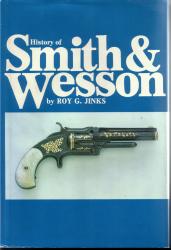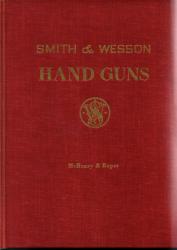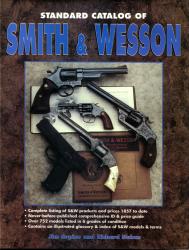|
The Smith & Wesson .38/44 Heavy Duty Revolver |
|
|
|
|
|
CRUFFLER.COM
presents
HISTORIC
FIREARM OF THE MONTH,
August
2001:
|
The Smith & Wesson .38/44 Heavy Duty Revolver |
|
|
Type:
Double Action Revolver
System of Operation: Manual Caliber: .38 High Velocity (.38 Special) Capacity: 6 round cylinder Sights, front: Fixed Blade Sights, rear: Fixed Notch Length: 10.83" Weight (unloaded): 42 ounces Barrel: 5.5" |
HISTORY
The introduction
of smokeless propellant in the latter portion of the nineteenth century
had a very significant effect on rifle cartridge ballistics. Literally
overnight the average velocity of a rifle projectile was doubled.
Range, penetration and trajectory showed similar improvements. Despite
the enhanced performance made possible by the use of smokless propellant,
very little effort was made to improve handgun ballistics until after 1930.
While most manufacturers had begun to load their cartridges with the new
powder, they had duplicated the old ballistics by loading a smaller amount
of smokeless propellant. Indeed, in the period following World War
One there was only one American handgun cartridge in production with a
muzzle velocity in excess of 1,000 feet per second. Despite this
high level of performance, the cartridge in question, the .38 ACP remained
in comparative obscurity since its introduction at the turn of the century.
The .38 ACP's unpopularity lay primarily in the fact that Colt hadn't chambered
anything new for it since the original parallel ruler models that were
obsolete at best. The .38 ACP's wallflower status was a loss to the
firearms community as a whole. With a muzzle velocity of 1,146 feet
per second and a 130 grain projectile, the .38 ACP generated about 380
foot-pounds of muzzle energy. It also exhibited better penetration
characteristics than the 7.63mm Mauser or the 9mm Parabellum. Additionally,
the cartridge possessed excellent long range characteristics. Fortunately
for the .38 ACP, a historical accident was about to rescue it from historical
obscurity.
During the First World War, various forms of body armor had been fielded by the combatants. These ranged in type from solid plate armor intended for r machine gunners to amalgams of chain mail and padded leather intended fr the brutal wars in the trenches. All of them were heavy and ungainly, and none of them would stop a rifle bullet; in consequence they were rapidly discarded after the war's conclusion. The wartime body armor found new employment after the war, in unlikely hands. Specifically, gangsters and other members of the underworld realized that the body armor would defeat any and all handgun bullets so long as they did not exceed 900 feet per second. This included standard police armament of the day such as the .38 Smith & Wesson, the .38 Special, and the .45 ACP. Disconcerted police began to report miscreants moving away under their own power despite being hit center mass with the contents of an officer's service weapon.
The mystery was uncovered when a lawman brought down a goblin with a head shot and discovered that the ex-criminal had been wearing an example of the wartime body armor. The recovered armor was subjected to a series of tests, which indicated that current service weapon ammunition was incapable of defeating it. The problem was turned over to Colt, who was charged with the task of developing a gun and cartridge combination that would overcome the armor. The task would not be easy; Colt continued testing the armor and found that it defeated every cartridge tested against it. Every cartridge save one, that is. The wallflower of the Colt line, the .38 ACP had no problem drilling neat holes in the armor time and time again. To ensure that the round would have the desired penetrative performance regardless of conditions, the velocity was increased to 1,300 feet per second. The resulting cartridge was known as the .38 Super Automatic. While the cartridge was up to the task, the old parallel ruler Colts were not, and a new firearm was designed for the new round. The pistol was basically a refined Government Model with the necessary internal dimensional changes required by the new cartridge. The new .38 Super pistol was adopted by a number of law enforcement agencies, to include the FBI.
As may be imagined, Smith & Wesson's corporate officers were not pleased to see their regular police customers deserting them for Colt and the new .38 Super. Hitherto, the police service weapon market had been dominated by the Smith & Wesson .38 Military and Police Model of 1905. However, the .38 Smith & Wesson Special round lacked the capability to penetrate body armor, heavy automobile bodies, and the newest innovations in bullet-proof glass. In late 1929 and early 1930, Smith & Wesson Vice President Daniel B. Wesson decided to remedy the problem. A detailed comparison was made between the .38 Special and the .38 Super. Bullet diameters were substantially the same at .359" for the Super and .357" for the Special. The Special launched a heavier, 158 grain projectile, as compared to the Super's 130 grain bullet. The Super, however, had a velocity of some 1,300 feet per second, which gave it a muzzle energy of approximately 487 foot-pounds. By contrast, the Special's projectile left the muzzle at a leisurely 847 feet per second, yielding only 252 foot-pounds. Penetration results were significantly better with the Super.
But the Special's case was just over a quarter inch longer. It had been designed in the waning days of the black powder era to hold a charge of twenty-six grains of black powder. With the changeover to smokeless propellant, the same velocities could be achieved using a much smaller amount of powder, leaving a substantial amount of case capacity unused. The Super, on the other hand, had been designed with smokeless propellant in mind, and was loaded very close to the case's capacity. Part of the solution to Smith & Wesson's problem was to increase the amount of propellant in the Special's case, thus creating a cartridge which would propel the Special's 158 grain bullet at 1,115 feet per second. The cartridge was christened the .38 High Velocity, or .38 HV. The other part was to develop a revolver to handle the increased pressures and recoil of the new round.
THE .38/44
HEAVY DUTY
The new revolver
was developed by fitting a cylinder and barrel bored for the .38 Special
cartridge to the "four screw" .44 caliber (later "N") frame. It was
discovered that the additional weight was quite effective at modifying
the new cartridge's recoil characteristics. The grip shape was also
modified with the inclusion of additional metal behind the triggerguard
to provide a firmer hold, and as it was intended for law enforcement work,
fixed sights were fitted. The production version of the gun, dubbed
the .38/44 Heavy Duty was unveiled on April 1, 1930. The name was
chosen to emphasize that the revolver's heavy construction would enable
it to not only stand up to the heavy recoil of the .38 HV, but to the rigors
of police service as well.
| The new .38/44 Heavy Duty was identical in construction to S&W's earlier .44 Hand Ejector Third Model, with the exception of its .38 chambering. Initially the gun was only offered with a 5" barrel, with a choice of either blue or nickel finishes, weighing in at 40 ounces. However, owing to its great popularity, S&W did manufacture the .38/44 Heavy Duty with special barrel lengths to satisfy specific law enforcement contracts. As a result, the gun can occasionally be found with 3.5", 4", 6", or 8.375" barrel lengths, with the 3.5" and 8.375" lengths being extremely rare. In March, 1938, S&W produced a dozen .38/44 Heavy Duty revolvers chambered for the .45 Long Colt cartridge. However, |
|
The .38/44
Heavy Duty was one of the most popular large frame revolvers during the
1930's. By the time the model was discontinued in 1941, S&W
had sold 11,111 revolvers. The .38/44 is serial numbered in the N
series, and is found scattered between serial numbers 35,037 and 62,350.
When commercial production resumed at the end of World War Two, the .38/44
Heavy Duty was reintroduced with the first revolvers completed on June
18, 1946. The postwar revolvers incorporated the new rebound slide
hammer block, and had S-prefix serial numbers to signify this design change.
The first postwar revolver was serial number S62,940. The postwar
design remained unchanged until 1948. At approximately serial number
S72,300 S&W incorporated new short hammer throw lockwork into the N-frame
revolvers. The .38/44 Heavy Duty remained a very popular revolver,
and by June 1952, postwar sales reached 1,214 units. However, the
.38/44's days were numbered. With the rising popularity of the .357
Magnum, sales of the .38/44 declined.
|
In
1957, Smith & Wesson began to assign model numbers to its various revolvers,
and the .38/44 Heavy Duty became the Model 20. Between 1957 and 1962
several design changes were incorporated that can be recognized by the
appearance of either a -1 or a -2 after the model number. These changes
included changing to a left hand thread for the extractor rod (-1), and
the incorporation of a cylinder stop, allowing for the elimination of the
screw in front of the triggerguard (-2). Despite the improvements
the .38/44's days were numbered. In 1966, after a post war production
run of some 20,604 revolvers, production of the .38/44 ceased, with the
last group of these revolvers having serial numbers S256,107 through S256,133.
|
THE .38/44
OUTDOORSMAN
The .38/44
Outdoorsman was the target version the Heavy Duty revolver, sporting an
adjustable rear sight. It was introduced on November 21, 1931.
Smith & Wesson literature on the Outdoorsman states: "This is
the second of Smith & Wesson's series of the Outdoorsman family, the
first being the famous K-22, which has made revolver shooting history."
As can be seen from this, S&W developed the the Outdoorsman to serve
as a heavy duty sporting revolver for the competitive shooter or the handgun
hunter who wanted a revolver that could handle heavy handloads.
The Outdoorsman was officially offered only in blue with a 6.5" barrel. Standard on the Outdoorsman were the Magna style stocks. The Outdoorsman was the first revolver to offer the Magna stocks as a standard feature. Magna stocks have an extension of wood that protrudes up onto the frame to give the shooter a more comfortable hold. The Outdoorsman was produced from 1931 to 1941 when it was discontinued due to wartime production. The last prewar Outdoorsman was serial number 62,483 in the N-frame series. Prewar production of the Outdoorsman amounted to some 4,761 revolvers.
Postwar production of the Outdoorsman began on August 10, 1946, and was identical to the prewar model except for the inclusion of the rebound slide hammer block, indicated, as with the Heavy Duty revolver, with an S-prefix serial number. Initial postwar production of the Outdoorsman was done with remaining stocks of pre-war parts. By 1949, these parts had been exhausted, and new parts were made for the Outdoorsman, modernizing its appearance. The new Outdoorsman, initially offered on September 26, 1950, offered a micrometer rear sight, a short throw hammer, and a ribbed barrel. The new Outdoorsman was known as the ".38/44 Outdoorsman Model of 1950."
In 1957, the .38/44 Outdoorsman was redesignated the Model 23, and underwent the same changes as the .38/44 Heavy Duty. While an excellent revolver, by the 1960's the .38/44 Outdoorsman had lost its popularity owing to the ascendancy of the .357 Magnum. As a result, it was dropped from the Smith & Wesson line in 1966. Factory records indicate a total production of 8,365, of which 6,039 were the 1950 style.
SHOOTING
THE .38/44
The .38/44
has an excellent reputation for accuracy, and we were eager to put this
to the test. To this end, we obtained a .38/44 Heavy Duty that had
been manufactured in 1935 and took it to the range with several types of
ammunition. We brought along some standard .38 Special ammunition,
some .38 Special +P ammunition, and some ammunition loaded so as to duplicate
the original .38/44 ballistics.
Like the rest of the N-frame line, the .38/44 is a big gun. Its size tends to emphasize a curiously anachronistic look; the smallish stocks, gracefully tapered barrel, and hemispherical fixed front sight contrast with the frame and cylinder, which seem to epitomize the modern revolver. Looks, however, can be deceiving. The revolver settles nicely into the hand, and the grips are comfortable for both large and small handed shooters. The tapered five inch tube makes for excellent balance and a naturally pointing firearm, and the sights are very well configured for rapid target acquisition.
Mechanically, the .38/44 was a joy. The single action trigger broke cleanly and lightly, and the double action mechanism was glassy smooth.
We fired the .38/44 for accuracy at 50 feet. The best accuracy of the day was had with Winchester Super-X .38 Special +P 158 grain lead semiwadcutters. (Note: For comparative purposes, Winchester lists the .38 Special 158 grain lead semiwaductter as having a muzzle velocity of 755 feet per second, and a muzzle energy of 200 foot-pounds, while the +P loading of the same bullet has a muzzle velocity of 890 feet per second and an energy of 278 foot-pounds.) These groups were slightly below the point of aim and centered, and were consistently cloverleaves where the six rounds in the string had all impacted within a bullet diameter of each other. Needless to say we were impressed. The standard .38 Specials didn't fare much worse, yielding an extreme spread of about 1.2". The .38 HV cartridges gave the "worst" accuracy of all, with a 2.3" group at 50 feet.
It's astounding
how much recoil the big N-frame soaks up. There was almost no perceptible
recoil when shooting standard .38 Specials; in fact, one of our testers
remarked that the gun moved no more than a Ruger Mk.II .22LR pistol loaded
with standard velocity .22's. The +P loadings produced slightly more
recoil, but there was no appreciable muzzle rise. The .38 HV rounds
produced a significant amount of recoil, on par with a 125 grain .357 Magnum.
However, unlike the magnum, there was a distinct absence of muzzle flash,
and the muzzle flip was much less evident.
CONCLUSION
The .38/44
revolvers represent a watershed moment in American firearms history, representing
the birth of the modern high performance revolver/cartridge combination.
A marriage of modern metallurgy, chemistry, and ballistics, the .38/44
breathed new vitality into the design of revolvers and ammunition.
It's one of history's ironies that the firearm that spawned the .357 Magnum
(and its later progeny, the .44 and .41 Magnums) is so often lost in the
.357's shadow. Despite this historical obscurity, a .38/44 is a wonderful
find for the collector or shooter. The workmanship on these guns
is exquisite, the accuracy superb, they're a joy to shoot, and they possess
an impressive historical pedigree. It's hard to imagine a firearm
more suited for shooting, collecting, studying, and, dare we say it - cruffling!
Special thanks to Phil Overly and the John C. Denner Company for all their help in making this article possible.
BIBLIOGRAPHY
Jinks, Roy G., History of Smith & Wesson, (Beinfeld Publishing, Inc., North Hollywood, California: 1983)
McHenry, Roy C., and Walter F. Roper, Smith & Wesson Hand Guns, (Standard Publications, Huntington, West Virginia: 1947)
Supica, Jim,
and Richard Nahas,
Standard Catalog of Smith & Wesson, (Krause
Publications, Iola, Wisconsin: 1996)
History
of Smith & Wesson is available from John C. Denner Company.
Click on the image to order:

Smith &
Wesson Hand Guns is an out of print volume. You can search for
it on any of many out of print search engines on the 'Net.

The Standard
Catalog of Smith & Wesson is available from John C. Denner Company.
Click on the image to order:
